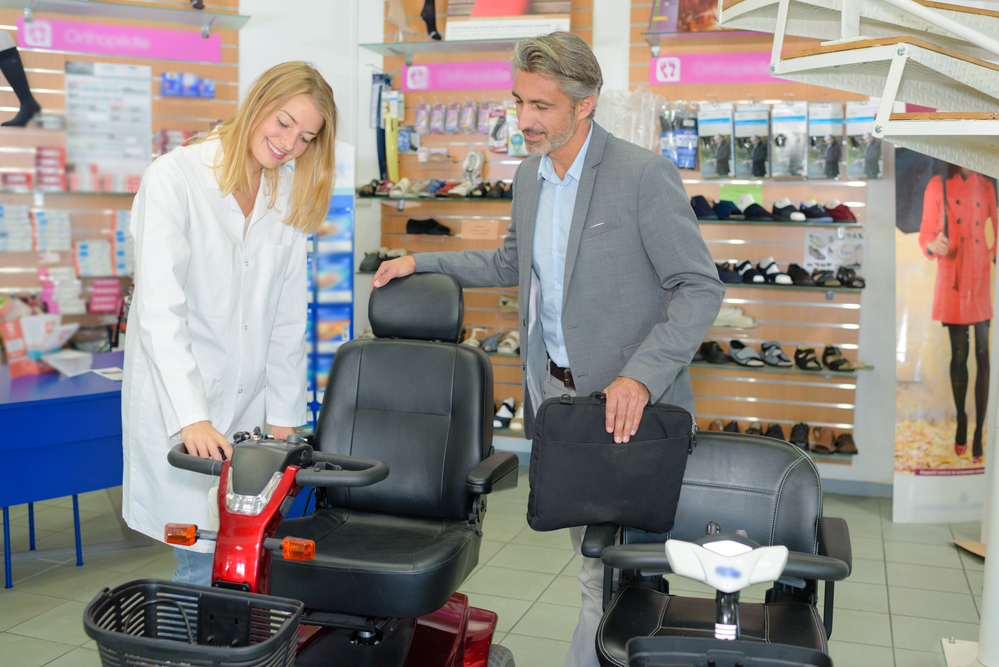Manual Wheelchair, Electric Wheelchair, or Power Scooter? Which Is Right for You?
 Mobility aids are essential to the independence of many individuals. They enable people to get around on their own more, and do things that they wouldn’t otherwise be able to do. But how do you know which type of mobility aid is right for you? Here’s a closer look at manual wheelchairs, electric wheelchairs, and power scooters, so you can decide which option best suits your needs.
Mobility aids are essential to the independence of many individuals. They enable people to get around on their own more, and do things that they wouldn’t otherwise be able to do. But how do you know which type of mobility aid is right for you? Here’s a closer look at manual wheelchairs, electric wheelchairs, and power scooters, so you can decide which option best suits your needs.
Manual Wheelchairs
The manual wheelchair has been around for centuries in various forms, and its basic design hasn’t changed much. Two large wheels form the primary means of support and propulsion for the attached seat, with smaller wheels in the front for balance. The chair can be pushed by someone from behind, or wheeled forward by grasping and rolling the wheels while seated in the chair.
This simple and effective design has many benefits. Manual wheelchairs tend to be smaller and more lightweight. This means that they can be transported more easily; you’re more likely to be able to fold and stow a manual wheelchair in the back of a standard van or SUV, instead of requiring a special vehicle for transportation. It also means that the user and the wheelchair could be lifted up steps, if no ramp is available. Most are also easier to navigate in tight spaces than their powered counterparts.
Because manual wheelchairs don’t require batteries, and they have fewer moving parts, maintenance and upkeep are simple and inexpensive. They’re less likely to break down unexpectedly, so you won’t find yourself stranded with a power wheelchair or scooter that refuses to budge. And, they’re going to be the least expensive option available.
But, of course, there are drawbacks to this simplistic mobility aid as well. The user has to have the right level of upper body strength and all-around balance to be able to propel the chair forward on their own. But, even if the user has the necessary strength, even the strongest of individuals will tire over time; using a manual wheelchair makes going long distances or up steep slopes much more difficult. Long-term use can also lead to wear and tear on the shoulder joints in some individuals.
Power Wheelchairs
Power wheelchairs were introduced to allow individuals to move independently, even if they didn’t have the necessary upper body strength to operate a manual wheelchair. These chairs are similar in design to manual wheelchairs, but with the added battery and other necessary parts to propel the chair forward without manual labor.
The greatest benefit of these chairs is that no minimum strength is required to operate them. For individuals with certain conditions, like muscular dystrophy, this can be an enormous benefit; such conditions would make it impossible for the patient to operate a manual chair on their own, but with a power wheelchair, they still have the ability to maintain some independence of mobility.
Power wheelchairs allow individuals to go great distances without fear of tiring. And, you can choose from several different drivetrains to ensure the wheelchair can handle the terrain you cover most often, so you can join your family on walks through the park without worry.
Of course, this style of wheelchair is going to be more expensive than a manual one, and will also have higher maintenance costs. You’ll also need to remember to charge the battery regularly, or your wheelchair will stop working on you.
Power Scooters
Like power wheelchairs, mobility scooters have a battery and motor that allow the device to move without manual labor. However, the purpose of a scooter is very different from that of a power wheelchair. Power scooters are intended for use by those who may be able to walk short distances by themselves, but may require a mobility aid for anything longer than a walk around the house.
For example, an elderly individual who can move about their home independently, or even with the use of a cane or walker, may be well served by a power scooter when they wish to join friends or family on a walk or go to the grocery store. However, an individual with a medical condition that makes them unable to move about their home on their own would be better served by a power wheelchair. Power scooters also require a bit more upper body strength and mobility, as they use a tiller and handlebars, as opposed to the joystick-like operation of a power wheelchair.
Power scooters also require regular maintenance, and are usually comparable in price to a power wheelchair, depending on the models you’re comparing.
If you’re unsure whether a manual wheelchair, power wheelchair, or mobility scooter is right for you, call or stop by one of our many locations. We’d be happy to help you find a mobility aid that perfectly suits your needs.